Frequency Diagnostics and Therapy in Veterinary Medicine: A Case Report
by Alena Micháľová*, Mária Fialkovičová, Radka Staroňová, Lukáš Kunay, Branislav Lukáč, Nicol Kořená, Martina Vargová
University of Veterinary Medicine and Pharmacy in Košice, University Veterinary Hospital, Department of Internal Medicine, Komenského 73, 041 81 Košice, Slovakia
Animed s.r.o., Zvolen, Slovakia, Clinical Research Department, Borovianska 76, 96001 Zvolen
*Corresponding author: Alena Micháľová, University of Veterinary Medicine and Pharmacy in Košice, University Veterinary Hospital, Department of Internal Medicine, Komenského 73, 041 81 Košice, Slovakia
Received Date: 28 October 2025
Accepted Date: 11 November 2025
Published Date: 14 November 2025
Citation: Micháľová A, Fialkovičová M, Staroňová R, Kunay L, Lukáč B, et al. (2025) Frequency Diagnostics and Therapy in Veterinary Medicine: A Case Report. Curr Res Cmpl Alt Med 9: 275. https://doi.org/10.29011/2577-2201.100275
Summary
Diagnostics and therapy by bioresonance are alternative methods used in modern medicine, that was discovered as a combination of quantum physics and traditional Chinese medicine (TCM). We can use it for various types of acute and chronic diseases without any invasive intervention into the body. There are also very positive results in the diagnosis and therapy of allergies in dogs, which are nowadays constantly increased, and that have been one of the most common causes of dermatological diseases.
Keywords: Bioresonance; Alternative medicine; Allergy; Diet; Pruritus
Introduction
Bioresonance is a biophysical diagnostic and therapeutic method that belongs among complementary medicine and is becoming an increasingly popular and sought-after therapeutic method in the field of human and veterinary medicine. The advantage of this method is the non-invasive intervention into the body, which, through quantum physics and knowledge of traditional Chinese medicine (TCM), ensures a deep effect on the biological regulatory systems of the body. While the body has a phenomenal regulatory system, in today’s world it is exposed to many stressors such as molds, allergens, stress, dust, food aditives, etc., which can be result of the slowed or blocked regulatory ability of the organism. The essence of this entire technique is the mutual communication between cells, based on the principles of quantum physics according to quantum model.
In classical medicine, we are accustomed to thinking in a linear way. This means that one action triggers a reaction (A), which triggers another reaction (B), and that triggers another reaction (C), and so on, so one action invokes a whole chain of linearly following reactions [1].
A → B → C → D → E
From the perspective of quantum medicine, also as in TCM, the rule applies that if a disorder occurs in one organ (A) in the body, the organism will respond to this dysfunction as a whole unit, and changes will appear simultaneously in all organ systems (B, C, D, E) [1]. This holistic approach in therapy perceives the patient as a whole. For example, if some change occurred in the liver, it would not only affect the activity of the heart, controled by the liver according to principles of TCM, but through holistic pathways, changes in the liver would significantly influence the function of the spleen, lungs, and kidneys as well. Any changes in the organ systems may not be immediately evident at the level of biochemical blood tests or may not be clinically apparent, because all changes first occur at the energetic level and only later manifest in clinical form [2].
According to quantum physics, matter is essentially energy, and all substances, including individual parts of the body, viruses, toxins, pollens, bacteria, etc., have their own electromagnetic radiation. Because organs and cells communicate together, any biological dysfunction may be the result of faulty cellular communication in any branch of the entire information flow [3]. In a healthy organism, this intercellular communication occurs smoothly, however, any exposure to radiation or stress in the form of a pathogen, toxin, or allergen can disrupt this intercellular communication. As a result of this disrupted cellular communication, symptoms such as chronic fatigue, weakness, depression, stress, and subsequent organ changes arise [4]. Each such dysfunction can be recorded and subsequently corrected through bioresonance, which is based on the principles of quantum physics and TCM. The advantage of this method is that doctors do not need to study TCM separately, but through special programs and sets available with the device, they can diagnose the patient also from the perspective of traditional medicine [5]. Diagnosis and therapy consist of several steps. The first step is bioenergetic testing, the second one is a burdens identification and the third one is the determination of therapy.
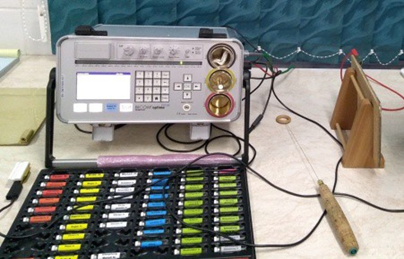
Figure 1: Bioresonance device and a set of five elements.
Patient testing is carried out using a basic test set, and specialized sets that are used for more detailed diagnostics. The basic test set consists of a set of five elements, which, according to TCM, identifies the energetic relationships in the body. Through this set, we can determine whether a specific organ, organ system, organ degeneration, or stress is affected, as well as whether the course of the disease is acute or chronic. After completing the diagnostics, we proceed the individual therapy. Using individual programs and specialised sets designed for the device and own body samples we can test food and inhalation allergens, bacteria, heavy metals, degenerated cells, parasites, and more.
In the past, several case reports, observational and scientific studies on the mode of action in the field of biophysics have been described and published, demonstrating that power from the electromagnetic spectrum have a profound effect on the body’s biological regulatory systems [6]. Our contribution deals with the description of bioresonance therapy in the case of food allergy in a young female dog with dermatological symptoms accompanied by pruritus. Our case demonstrates the treatment of a chronic condition that requires long-term management and harmonization of digestive mechanisms in the gastrointestinal tract and a management of the skin problems.
Clinical Case
A one-year-old female dog was adopted from a shelter at the age of seven months. She suffered from anxiety and food intolerance. She reacted to the administered feed with diarrhea, vomiting, and increased flatulence. Borborygmi were audible during digestion. Skin manifestations included erythema, pustules, urticaria, and vesicles accompanied by intense pruritus, leading to the formation of small crusts. Dermatological lesions were located around the eyes, in the axillae, and on the ventral side of the abdomen. Since the animal experienced intense pruritus, the female dog was administered a Cytopoint injection. The diet was also changed and the animal’s condition was stabilized, but after three weeks occured pruritus followed by symptoms of erythema and superficial folliculitis. The skin was warm to the touch, and hyperkeratinization and hyperpigmentation of the affected areas of the body were observed. The animal was administered Cytopoint injections again. The itching subsided, but after 4 days, the pruritic condition returned (Figure 2). Therefore, the owner decided to try a different therapeutic method—an alternative one that might improve the patient’s condition. We chose therapy through bioresonance device.
Diagnosis and therapy
A basic clinical examination, hematological and biochemical tests were performed on the dog. The haircoat was dull. The skin in the abdominal area was red, dry, itchy and warm to the touch with the presence of vesicles. The animal’s tongue was red and dry, and the pulse was fast. The animal appeared very frightened, but without aggression. Haematology and biochemistry examinations were carried out (Table 1 and Table 2).
|
Parameter |
Ery 5,65-8,87 ×10ˆ12/L |
Leu 5,05-16,76 ×10ˆ9/L |
Neu 2,00-12,00 K/µL |
Lym 0,50-4,90 K/µL |
Eoz 0,10-1,49 K/µL |
|
Before therapy |
7,4 |
13,8 |
9,7 |
4,5 |
*1,72 |
|
After therapy |
7,7 |
12,1 |
9,5 |
4,8 |
1,47 |
Table 1: Hematological results before and after the application of bioresonance therapy.
Among the hematological parameters, only the eosinophil count was elevated, which returned to the reference range after therapy.
|
Parameter |
ALT ˂0,949 µkat/l |
ALP ˂1,24 µkat/l |
pAMS ˂7,21 µkat/l |
LPS ˂1,66 µkat/l |
BUN 3,97-8,05 mmol/l |
CREAT 46-88 µmol/l |
CHOL 3,3-7,4 mmol/l |
|
Before therapy |
0,55 |
0,49 |
4,34 |
0,6 |
6,72 |
75,5 |
4,55 |
|
After therapy |
0,53 |
0,47 |
4,52 |
0,59 |
6,23 |
68,5 |
4,55 |
Table 2: Biochemical results before and after the application of bioresonance therapy.
There was no significant change either before or after therapy in the biochemical parameters.
From a holistic medical perspective on the patient, we can state that the female dog was at an elevated energy level, had multiple energy blockages, and needed detoxification. We began diagnostics and therapy with a classic bioresonance protocol consisting of calming the animal using an anti-stress ampoule containing Bach flower frequencies (Rescue Remedy). Subsequently, we balanced the levels of yin and yang based on positively confirmed frequencies in the animal, removed energy blockages, and performed detoxification. All of this was based on frequencies that resonated directly with the animal.
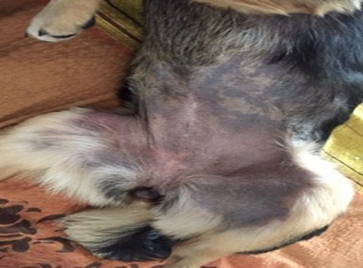
Figure 2: Condition of the animal at the beginning of the bioresonance therapy. The female dog was fed hypoallergenic lamb diet.
The first therapeutic step we was a change in diet. All types of feed and foods that had been given to the patient so far were tested through bioresonance, which, based on inverted frequencies, confirmed which types of feed were suitable for the dog and which were harmful. After testing, we customized the animal’s diet using specifically tested foods (rice, cottage cheese, rabbit meat and visceras, salmon, carrot, zucchini). The clinical condition of the skin gradually improved, and pruritus was significantly reduced. Similarly, the frequency and quality of the stool also improved (Figure 3).
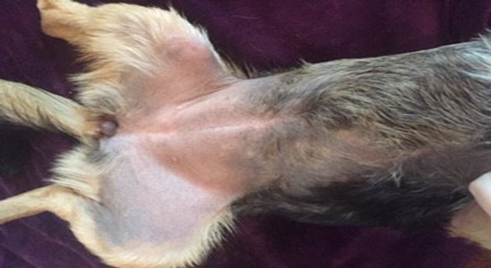
Figure 3: Condition of the animal after changing the diet (cottage cheese and rice). The animal was also administered Phytolergan suspension and Normaderm solution.
In this improved and stabilized condition, which lasted several months, the owner decided on regular vaccination. Within a few days, skin erythema with macules, pustules, and pruritus reappeared (Figure 4). We again used bioresonance therapy for treatment.

Figure 4: Condition of the animal after vaccination, when the condition has worsened.
Bioresonance therapy at this stage of treatment (Figure 5) again consisted of the basic program, which adjusts the patient’s condition according to the classic TCM principle. Since the patient was in a state of increased energy, we used the basic program to regulate his energy excess. Later, we continued with the elimination of the patient’s blockages, which cause incomplete energy flow in the body, and subsequently proceeded with detoxification programs for the liver, kidneys, and lymph. During the therapies, we also applied programs to strengthen the immune system and antipruritic programs for the patient. Additionally, we selected appropriate types of natural preparations as complementary therapy for the dog, Phytolergan oral suspension and Normaderm solutio, whose suitability we also confirmed through bioresonance. Phytolergan oral suspension is used to strengthen the immune system, containing natural immunoglucan (beta 1,3-1,6 D-glucan), plant extracts of Glycyrrhiza glabra, ascorbic acid, and zinc, which enhance the effects of glucans. The preparation is intended to increase immunity, support the body’s regenerative and reparative processes, promote healing of wounds, non-healing skin lesions, eczematous conditions, and also ulcerative diseases of various etiologies. Normaderm solutio is an oil-based nutritional supplement containing essential omega-3 and omega-6 fatty acids necessary for the protection and maintenance of healthy skin, haircoat, and keratinized structures in dogs and cats. Administration serves as supportive therapy for dermatoses, hair loss, allergic skin irritations, and skin inflammation and the essential fatty acids have an important role in protection against endotoxins. If lack the most common symptom is precisely impaired skin and skin derivative function, manifesting mainly as dryness, scaling, hair loss, and increased brittleness of keratinized structures.
The patient’s condition significantly improved with bioresonance therapy after just three weeks, with the therapy being administered once a week. The female dog was calmer, pruritus disappeared, and her coat started to regrow (Figure 6). The diet was changed to beef and viscera, rice, and vegetables.
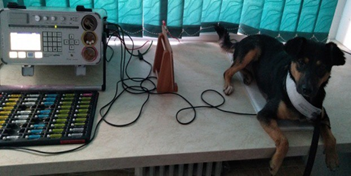
Figure 5: Bioresonance therapy of the patient.
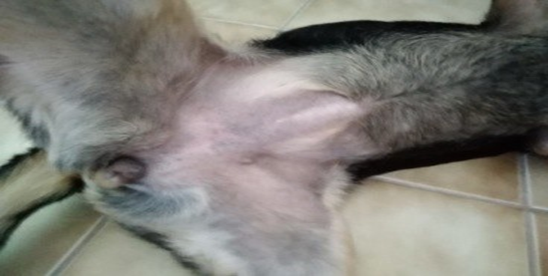
Figure 6: Condition of the animal after the 3rd bioresonance therapy. The hair on the ventral abdomen has regrown, and the pruritus has been completely eliminated.
Using an individualized and precisely defined diet, which was tested through bioresonance, the patient’s clinical condition improved over the long term. Digestion proceeded without increased flatulence, diarrhea, or audible borborygmi. The skin is without erythema, efflorescences, and without pruritus.
Discussion
Food allergy, associated with skin allergy symptoms and pruritus, is a problem for many animals and can begin at a young age [7]. Gastrointestinal symptoms including chronic diarrhea, anorexia, increased flatulence, vomiting, and borborygmi, which are closely related to food allergy and persist for longer than 3 weeks, fall into the category of chronic inflammatory enteropathies (CIE). The mentioned CIE can be distinguished and classified according to response to therapy as food-responsive enteropathy (FRE), which responds to dietary therapy; antibiotic-responsive enteropathy (ARE), which responds to antimicrobial therapy; immunosuppressant-responsive enteropathy (IRE), which responds to immunosuppressive therapy such as steroids; and non-responsive enteropathy (NRE), which does not respond to these therapies [8]. It has been reported that FRE responds to an elimination diet as early as a few days or as late as 10-14 days [8,9]. It is difficult to differentiate CIE using methods other that treatment response [10]. It has been reported that 79% of cases that went into remission on an elimination did not relapse when returned to the previous original diet after 14 weeks, and 21% of FRE cases that relapsed after returning to the previous diet were thought to be food allergies [9,11]. FRE accounts for approximately 65% of CIE in young dogs [12,13].
Some authors describe cases of patients with pruritus and skin problems, which are thought to be caused by food allergies, showed recurring clinical signs and were euthanized due to poor response to treatment [9,10]. This factor also increases the importance of using other diagnostic and therapeutic methods, such as bioresonance, to support a deep effect on the biological regulatory systems of the body [6]. In classical medicine, the diagnosis of allergic diseases is relatively time-consuming and sometimes financially demanding. Pruritic dermatological problems are mainly treated symptomatically, where the first and fastest therapeutic choice are corticosteroids as well as Janus kinase inhibitors, which, although they stop pruritus in most patients, do not resolve the underlying cause [7,14,15].
In the case of a food allergy, it is necessary to adjust the diet according to the patient’s needs, the season, and to unconditionally exclude all inappropriate foods and not feed them to the animal [16]. The dog’s diet may change over time depending on its current health condition, so it is important to monitor and control this. With this diagnosis, according to TCM, it is advisable to feed the animal energetically ‘cool’ types of food and limit the intake of ‘warm’ types of food. Based on several studies conducted on patients suffering from allergy with pruritus, it has been shown that about 63% of allergic patients were completely cured by bioresonance therapy, 20.5% of patients experienced significant improvement after therapy, 10.2% of patients had mild improvement, and 6.3% of patients showed no change after therapy [5]. In addition to bioresonance therapy, which improves the condition of allergic patients in most cases, it is also important to eliminate the pathogenic factor [17].
As part of phytotherapy, we applied a commercial product, Phytolergan oral suspension, containing licorice, beta-glucan, zinc, and echinacea. Licorice (Glycyrrhiza glabra) is a natural precursor of cortisol. Since it has mineralocorticoid and glucocorticoid effects, it increases the duration and effectiveness of cortisol in the body. It reduces the secretion of gastric juices and has antiulcer effects. According to TCM knowledge, licorice tonifies the spleen and Qi energy, moistens the lungs, and stops coughing; it is suitable for asthmatic and pruritic conditions, eliminates toxic Heat, which is one of the pathogenic factors. It acts against spasms and has harmonizing effects on the body. However, caution should be taken with overdosing, as it could cause edema. Licorice contains potassium, which creates an imbalance between sodium and potassium, cardiac arrhythmia, and hypertension. It is also contraindicated in type I diabetes due to its sweet taste [18]. This preparation was administered to the dog for two weeks. Betaglucans are among the leading immunomodulators and activators of white blood cells, particularly macrophages, which are capable of significantly accelerating the body’s regeneration process [19]. In addition to their immunostimulatory effect, they also have anti-infective and antifungal activity and increase the body’s resistance. Beta-glucans influence the hematopoietic activity of the bone marrow and stimulate other effector cells of the immune system – cytotoxic T lymphocytes and NK cells, with subsequent anticarcinogenic effects [20,21]. Its practical application generally increases activity, alleviates clinical symptoms of the disease, accelerates the healing process and reduces secondary infections, increases the effectiveness of causal therapy and the prognosis of healing. Beta-glucan also has an adjuvant effect in enhancing the efficacy of treatment with other drugs, such as antibiotics and natural supplements [22]. It is also safe and non-toxic for animals [23].
The therapy also included the preparation Normaderm oral solution, containing essential omega-3 and omega-6 fatty acids. These fatty acids play an important role in all physiological processes at the most fundamental level and are effective in treating any health condition such as allergies, diabetes, cancer, inflammatory processes, etc. These fatty acids serve as ‘parent fatty acids,’ because the body can then use them to create other fats, which are subsequently utilized in other cellular functions. In addition, the preparation has a beneficial effect on the cardiovascular system. The anti-inflammatory effect is used in the treatment of musculoskeletal disorders. It supports proper brain activity and positively influences the immune system. Omega-3 and omega-6 fatty acids are important components of cell membranes and precursors of various substances involved in certain essential processes in the body (regulation of blood pressure, inflammatory processes, etc.). They affect the release of prostaglandins and leukotrienes in inflammatory allergic reactions [24]. They are essential for healthy skin because they help relieve inflammation, improve pruritus and have been a very beneficial part of treatment in the management of canine atopic dermatitis and hypersensitivity reactions [25].
Conclusion
The bioresonance method is essentially a non-invasive, complementary method that operates on the principle of biophysics, capable of diagnosing and simultaneously treating diseases. It can also independently test suitable medications, nutritional supplements, and foods for each patient individually. With its personalized diagnostic and therapeutic approach, it is becoming increasingly popular, favored, and coveted as a diagnostic and therapeutic method among patients.
References
- Lipton B (2005) Biológia presvedčenia. Slovenské vydanie, Eugenika Pbl. 2011, Bratislava 2011: 105-111.
- Li-Ling J (2003) The Jing-Mai connections of the heart. Int J Cardiol 89:1-11.
- Paolelli Ermanno, Neurocúantica La nueva frontera de la neurociencia, Primera edieción en Espaňa, Ediciónes el Grano de Mostaza S.L. 2015.
- Zhang Xinlian, Wang Wenjie, Liu Qiang (2005) Clinical observation of 54 cases treated for nettle rash using the BICOM bioresonance therapy device: China Scientific and Technical Journal, China Academic Journal (official translation) 21:8.
- Hennecke J (2012) Bioresonance: a new view of medicine. Books On Demand p. 45-168.
- Huang Shuiming, Sun Zhangping, Fang Yucai (2005) Clinical observation of the treatment of allergies and bronchial asthma in children with the bioresonance therapy device; Zhejiang Medical Journal (official translation), Edition 6/Volume 27.
- Jackson HA (2023) Food allergy in dogs and cats; current perspectives on etiology, diagnosis and management, JAVMA 261:S1.
- Dandrieux JRS (2016) Inflammatory bowel disease versus chronic enteropathy in dogs: are they one and the same? J Small Anim Pract 57:589-599.
- Allenspach K, Wielan B, Gröne A, Gaschen F (2007) Chronic enteropathies in Dogs: Evaluation of Risk Factors for Negative Outcome. J Vet Intern Med 21:700-708.
- Tamura Y (2025) Chronic Enteropathy and Vitamins in Dogs. Animals 15:649.
- Gaschen FP, Merchant SR (2011) Adverse Food Reactions in Dogs and Cats. Vet Clin North Am Small Anim Pract 41:361-379.
- Allenspach K, Culverwell C, Chan D (2016) Long-term outcome in dogs with chronic enteropathies: 203 cases. Vet Rec 178:368.
- Volkmann M, Steiner JM, Fosgate GT, Zentek J, Hartmann S (2017) Chronic Diarhea in Dogs- Retrospective Study in 136 Cases. J Vet Intern Med 31:1043-1055.
- Svoboda M. et al: Choroby psa a mačky. 1. Diel, Brno, 2000: 336, ISBN: 80-902595-2-9.
- Dandrieux JRS, Mansfield CS (2019) Chronic Enteropathy In Canines: Prevalence, Impact And Management Strategies. Vet Med (Auckl) 10:203214.
- Wagner C (2014) Avaiable online.
- Schoen AM (1994) Veterinary acupuncture: Ancient art to modern medicine [1st ed] : 50- 245. Edit for SCHOEN A.M. Saint-Louis : MOSBY.
- Omar HR, Komarova I, El-Ghonemi M, Fathy A, Rashad R, et al. (2012) Licorice abuse: time to send a warning message. Ther Adv Endocrinol Metab 3:125-138.
- Bohn JA, Bemiller JN (1995) (1→3)- β-D-Glucans as biological response modifiers: A review of structure-functional activity relationships. Carbohydr Polym 28:3-14.
- Jantova S, Bakos D, Birosova L, Matejov P (2015) Biological properties of a novel coladerm-beta glucan membrane. In vitro assessment using human fibroblasts. Biomed Pap Med Fac Univ Palacky Olomouc Czech Repub 159:67-76.
- Stier H, Ebbeskotte V, Gruenwald J (2014) Immune-modulatory effects of dietary Yeast Beta-1,3/1,6-D-glucan. Nutr J 13:1-9.
- Haladová E, Mojžišová J, Smrčo P, Ondrejková A, Vojtek B, et al., (2011) Immunomodulatory effect of glucan on specific and nonspecific immunity after vaccination in puppies. Acta Vet Hung 59:77-86.
- Vannucci L, Krizan J, Sima P, Stakheev D, Caja F, et al. (2013) Immunostimulatory properties and antitumor activities of glucans. Int J Oncol 43:357-364.
- Campbell- MCbride, N. Syndróm trávenia a psychológie. Prírodná liečba. Prvé slovenské vydanie. Vydavateľstvo Európa s.r.o. 2010. ISBN: 978-8089111-68-8. s. 179-185.
- Schumann J, Basiouni S, Gück T, Fuhrmann H (2014) Treating canine atopic dermatitis with unsaturated fatty acids: The role of mast cells and potential mechanisms of action. J Anim Physiol Anim Nutr 98:1013-1020.
© by the Authors & Gavin Publishers. This is an Open Access Journal Article Published Under Attribution-Share Alike CC BY-SA: Creative Commons Attribution-Share Alike 4.0 International License. Read More About Open Access Policy.